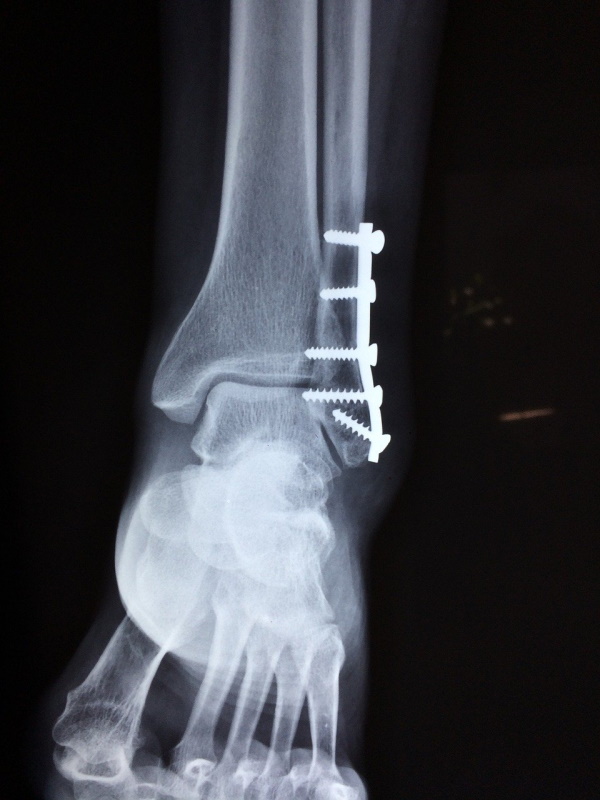Stress fractures or hairline fractures are small cracks within a bone. They are usually caused by overuse or repetitive force like running long distances or jumping up and down. And that’s why they are quite common with athletes who participate in high-impact sports like running, basketball and soccer. Stress fractures can also occur from normal bone use, especially if that bone has been weakened by conditions like osteoporosis. The bones of the leg and foot are more prone to stress fractures compared to those in the other parts of the body since they are involved in all activities that require standing or walking.
Causes
One of the most common causes of this foot condition is a sudden increase in the frequency or intensity of a physical activity. For example, if you were only exercising two days per week and you increase the frequency to 5 days, you might end up with stress fractures. Also, if you were running 3 miles and you suddenly increase the distance to 6 miles or even more, there is a high chance of developing stress fractures. If you are a swimmer, you might sustain a stress fracture is you suddenly take up another intense activity such as running. Non-athletes are also at risk of developing stress fractures if there is a sudden increase or change in activity. For instance, if you were only used to standing at work for a few minutes but suddenly start standing on hard surfaces the entire day, you might end up with a stress fracture. Other predisposing factors of stress fractures include:
- Low bone density: Health problems that decrease bone density and strength like osteoporosis, as well as some long-term medications, can increase the risk of sustaining stress fractures, even when you are not engaged in intense physical activities. For instance, studies show that stress fractures tend to be more common during the winter months since vitamin D is lower in the body. Also, women, especially those with abnormal or absent menstrual periods are at a high risk of sustaining these fractures. And this can be attributed to a condition known as the “female athlete triad.” When a young woman or a girl goes to extremes in exercise and dieting, they might end up with menstrual dysfunction, eating disorders as well as premature osteoporosis, which will eventually increase their risk of getting hairline fractures.
- Poor conditioning: As noted earlier, a sudden increase in intensity or frequency of physical activities can lead to stress fractures. And that’s why it’s quite a common injury in people who have started a new exercise program or taken up a new sport. However, it’s important to note that stress fractures can also happen to seasoned athletes. For instance, a runner might decide to slow down their training during the winter months, due to the poor weather conditions. When the weather improves, they might want to continue straight from where they left off. This means that they will resume training at their previous mileage, instead of starting off slowly and then upping the mileage gradually. Such a situation can result in stress fractures since the athlete hasn’t given their body ample time to recover.
- Change in a surface: A change in running or training surface can increase the amount of pressure and stress exerted on the legs and feet. For instance, if you are a runner and you are used to training on the treadmill, moving to an outdoor track or a pavement can increase the risk of sustaining stress fractures.
- Poor technique: Foot and leg conditions like tendonitis, bunions, and blisters can affect how your foot strikes the ground when you are running or walking. As a result, a certain area of the foot will be forced to handle more pressure than it’s used to, and this might lead to stress fractures.
- Improper equipment: Exercising with ill-fitting, flimsy, worn or shoes that have lost their cushioning and support capabilities can lead to hairline fractures. Therefore, you should always ensure you are wearing the right pair of shoes for the activity you are engaged in.
People who have had one or more hairline fractures in the past are also at risk of getting these injuries. Also, stress fractures tend to be more common in high-impact sports like tennis, dance, basketball, and gymnastics.
Symptoms of Stress Fractures
Stress fractures can occur on the foot, ankle, as well as any of the bones in the lower leg. It mainly affects the heel bone, the metatarsals connecting the mid-foot to the toes, the navicular as well as the fibula and the tibia. So, what are the symptoms of this foot condition? Pain in the ankle or the foot is usually the most common symptom of hairline fractures. The area of the pain will depend on the specific bone that is injured.
If you have recently increased your training frequency or intensity and you’ve started to experience pain or inflammation on a certain area of the ankle or foot, there is a high chance that you might have stress fractures. The pain will then diminish when you rest and intensify when you are doing daily activities like standing or walking. Localized swelling and tenderness may also occur in the area of the injury.
Diagnosis and Testing
If you have experienced any of the above symptoms, there is a high chance that you might have sustained stress fractures. However, you should also note that there are various other conditions that might present like stress fractures such as sprains, strains, plantar fasciitis, shin splints, and Morton’s neuroma, among others. It’s, therefore, important to visit a physician as soon as possible. Your healthcare provider may ask some questions to help make the right diagnosis.
During the first, the physician will ask you some questions such as how long you’ve experienced the pain, whether it has changed or progressed and what worsens it. They will also ask about your medical history, nutrition history, as well as any medications you’ve used or you are currently using. That information will help to assess whether you have any predisposing factors for stress fractures. After that, your physician will physically examine the problematic area and apply gentle pressure to see how you respond. Pain in response to the pressure applied is usually a sign of stress fractures. Also, the physician may also check for muscle flexibility, strength as well as bone alignment. Your doctor may also recommend further tests like X-rays, MRI scans and bone scans, to help determine the extent of the injury.
Treatment and Management
Your doctor will recommend the appropriate treatment plan, depending on the results of the diagnostic tests. However, any treatment plan that is recommended will seek to alleviate the pain while allowing the fracture to heal.
Non-Surgical Approaches
Most stress fractures will heal on their own using non-surgical approaches. Rest, ice, compression and elevation, popularly known as the RICE protocol, combined with anti-inflammatory medication, will help to alleviate the pain and swelling. Your doctor may also recommend you to use crutches so that you don’t too much weight on the affected foot.
During the healing phase, you should avoid all activities that place stress on your leg and foot. Instead, you can opt for activities like cycling and swimming. However, make sure you first consult your doctor before you resume any physical activity, even if it’s a low-impact one. Apart from modifying your activities, the doctor may also recommend that you wear protective footwear to minimize the stress on your leg and foot. If the stress fractures have taken place in the talus, navicular or fifth metatarsal bones, then the physician may apply a cast on the affected foot, since these bones take longer to heal. The cast will keep these bones in a fixed position, thus preventing unnecessary movement, while minimizing stress on the affected leg.
Surgical Treatment
Stress fractures usually heal in 4 to 8 weeks, without any surgical approaches. However, some fractures may require invasive approaches like surgery to ensure the area heals properly. Most surgical approaches involve internal fixation – where screws, pins or plates are inserted into the affected area to hold the bones together and support them during the healing process. However, surgery is rarely needed. It will only be recommended if non-surgical and conservative approaches have failed to work.
Prevention
You might probably have heard that prevention is always the best treatment method. Well, the same case applies to stress fractures. As you can see, you will be forced to abandon all intense physical activities for up to 4 to 8 weeks. This means that you will not be running or playing football, tennis, basketball or any of your favorite sports. So, what can you do to prevent stress fractures? First, make sure you eat foods that are rich in calcium and vitamin D every day, to maintain bone strength and density. Second, wear proper shoes. Avoid wearing stiff, old or worn-out shoes. Instead, opt for supportive, well-padded and comfortable shoes. Third, vary and mix-up your training sessions so that you don’t overstress one area of the body. Also, you need to add strength training to your workout sessions. Incorporating strength training will help to prevent premature loss of bone density and early muscle fatigue.




0 comments